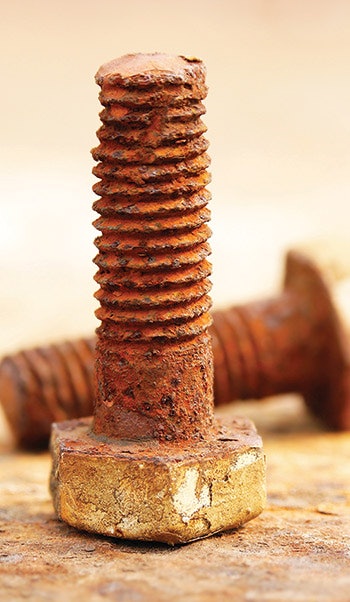
The higher concentration of salt required by saltwater systems has the potential to damage equipment and fixtures, a point that is often glossed over by people selling such systems to pool owners. The higher salt concentration results in greater conductivity of the water, which accelerates a process called galvanic corrosion — a concern that should be addressed by pool professionals.
In simple terms, a swimming pool is just like a giant primary battery. To make an ordinary primary battery in your high school science lab, you would submerge differential metals within an electrolytic solution. On a larger scale, that is the basic setup of a pool, with the water acting as an electrolytic solution (since it has salt in it) and differential metals (such as galvanized steel, stainless steel, aluminum, titanium, brass and copper) acting as the anode and cathode.
Now the amount of current generated between the metal components of the giant battery of your swimming pool is very small. It is not enough to feel shocks in the water, nor enough to be a concern for electrocution. The electric current generated is tiny. You could only detect this current with sensitive electronic testing equipment.
However, though the generated current is small, it runs 24 hours per day, seven days per week. This constant current can dramatically reduce the service life of a pool's integral metal components through galvanic corrosion, which is the result of a transfer of electrons between the dissimilar metals within the water.
RELATED: Case Study: How Stray Current Caused Extreme Corrosion
The reality is that all swimming pools experience galvanic corrosion if they use chlorine sanitizer. Chlorine is salt based, so by adding chlorine to a pool you are actually adding salt. A saltwater pool, however, has approximately ten times the salt level of a traditional chlorine pool. This is especially significant since there is a linear increase in galvanic activity between 0 ppm salt all the way up to ocean water levels of 25,000 ppm of salt. If a saltwater pool has ten times as much salt as a traditional chlorine pool, it means that the rate of galvanic corrosion also increases ten times.
 Figure 1. Galvanic chart (Click to enlarge)
Figure 1. Galvanic chart (Click to enlarge)
Figure 1. Galvanic chart
Galvanic corrosion occurs when dissimilar metals are in electrical contact, like the metals in a swimming pool system, which includes the metals in light fixtures and handrails and the metals in components like pumps and heaters. In this situation, the metal in the pool furthest to the right in this chart will become the anode, lose electrons and suffer corrosive attack. Note the position of zinc, varying grades of steel, copper, aluminum and other metals likely to be present in a pool system. The placement of a zinc (because of all the metals potentially present in the pool, zinc is furthest to the right on the galvanic chart) sacrificial anode in the system ensures it will become the anode in a galvanic coupling and bear the brunt of corrosive attack, instead of crucial metals elsewhere in the pool.
Bonding
Pool pros can help prevent galvanic corrosion with proper bonding and the use of sacrificial anodes.
While the vast majority of pools in North America are bonded with an equipotential bonding grid, this will often only be applied to the pool structure itself. Swimming pool equipment pads should be included in the bonding loop since they are, of course, part of the pool system. Each component of a pool system that contains metal should be bonded directly to the casing of the machine.
Filters do not usually require bonding, unless they are ancient and made from stainless steel, but almost all pumps and heaters will have a bonding lug somewhere on the casing.
If you do not bond pool equipment, you run the risk of the equipment itself becoming the anode in a galvanic couple with other metal components in or around the pool. If this happens, the anode metal will degrade through galvanic corrosion.
RELATED: How to Test a Swimming Pool Bonding Grid
Specifically, only the anode metal will corrode, while the other metal will experience enhanced resistance to corrosion from a process known as cathodic protection — a predictable electromechanical process. By not bonding the equipment you allow a potential difference (voltage) to exist between each component. By bonding the equipment you are forcing each piece to have the same electrical potential, which limits the potential for damage from galvanic corrosion.
Figure 2.
 Basic concept of galvanic corrosion showing degradation of the anode material. This process is ongoing in all pools. Efforts to limit its effects will preserve metal components.
Basic concept of galvanic corrosion showing degradation of the anode material. This process is ongoing in all pools. Efforts to limit its effects will preserve metal components.
Adding a Sacrificial Anode
Since galvanic corrosion attacks only the anode metal, a popular strategy is to add a piece of metal to the system that will fill that role. Since the metal device is being placed in the system so it will become the target of galvanic corrosive attack (and thus not other essential components), it is called a sacrificial anode. Its job is to suffer degradation so that other components will remain unharmed.
By adding a sacrificial anode to your pool plumbing installation and connecting it to the bonding grid, you effectively make the rest of your pool equipment the cathode in a galvanic couple. As discussed, this will provide cathodic protection to your pool equipment, which results in increased rust resistance. The sacrificial anode that you add will take the brunt of the corrosion damage, "sacrificing" itself in this process. Simply replace the anode over two to three years, or when the anode metal is reduced in size by half. This is something that all pools should have, and all saltwater pools must have.
Every swimming pool, and especially every saltwater pool, should have a sacrificial anode installed. The addition of this simple and low-cost device will dramatically reduce the damage a pool experiences as a result of galvanic corrosion. While you may still experience localized anodization and oxidation of metals in a pool, especially in situations where two different metals are in direct contact, a sacrificial anode is the bare minimum level of protection that every pool needs. It is absolutely silly to not have one of these — plus they can easily be adapted to any existing system.
RELATED: Dealing with Pool Stains? Identify Before You Treat
To help prevent localized problems around the pool, you can add additional sacrificial anodes, such as standalone zinc anodes that bolt directly to the ladder; you can also get zinc anode discs that can sit inside the skimmer basket.
Given their relatively low cost and the huge preventative protection they offer, there is no question that every pool should use sacrificial anodes.
Steve Goodale is a renowned writer, humorist and swimming pool expert who lives in Ontario, Canada. You can learn more about Steve, as well as swimming pool construction, maintenance and repair (and have a few laughs) at his website: SwimmingPoolSteve.com.












































